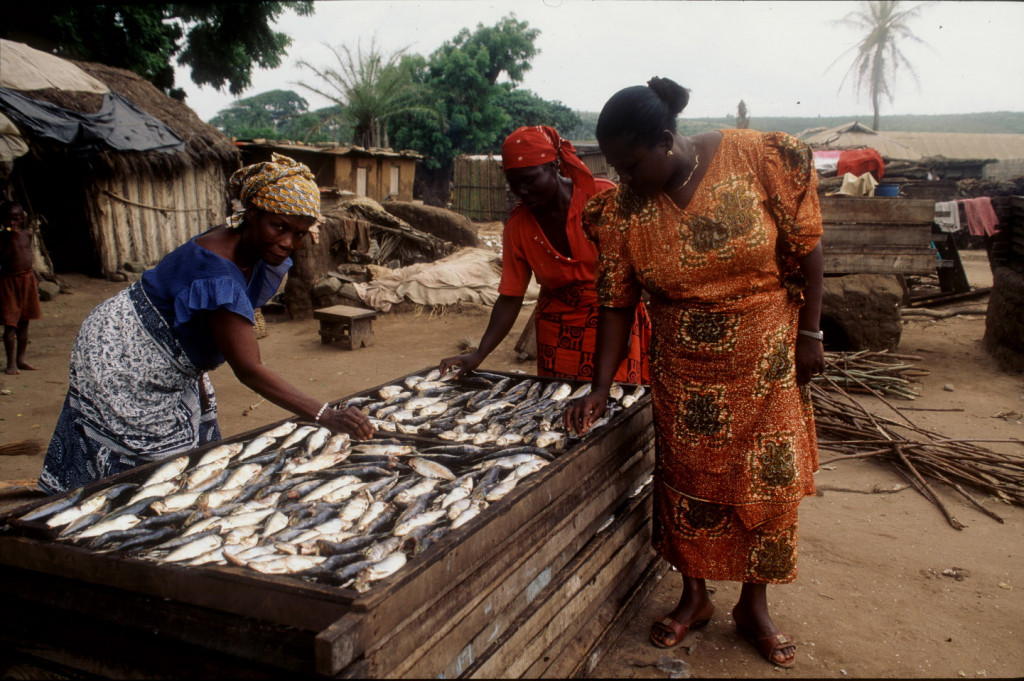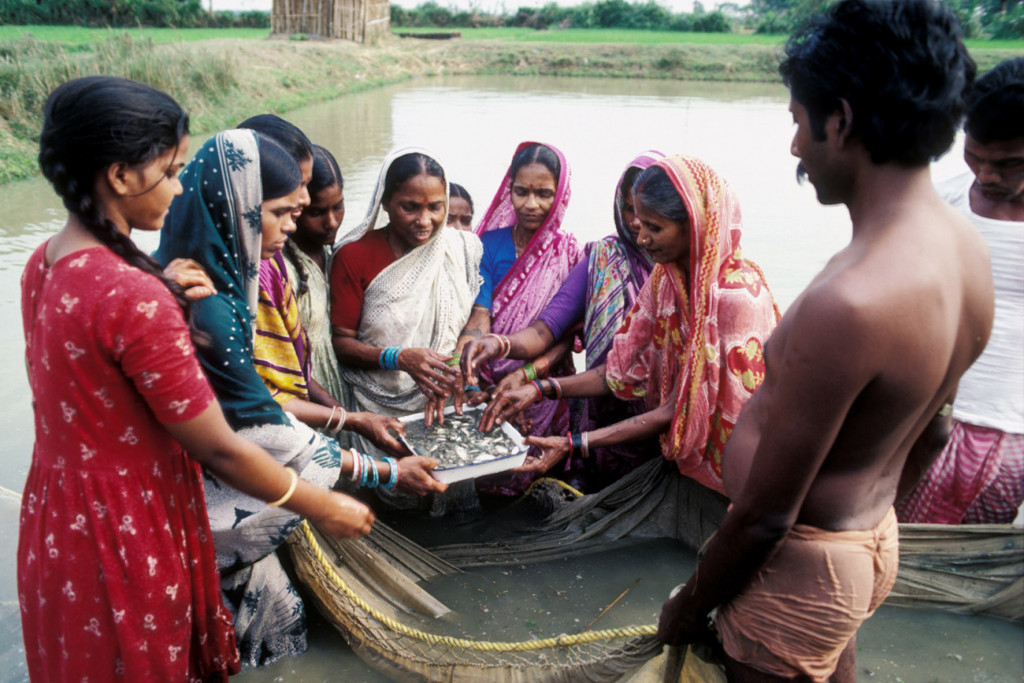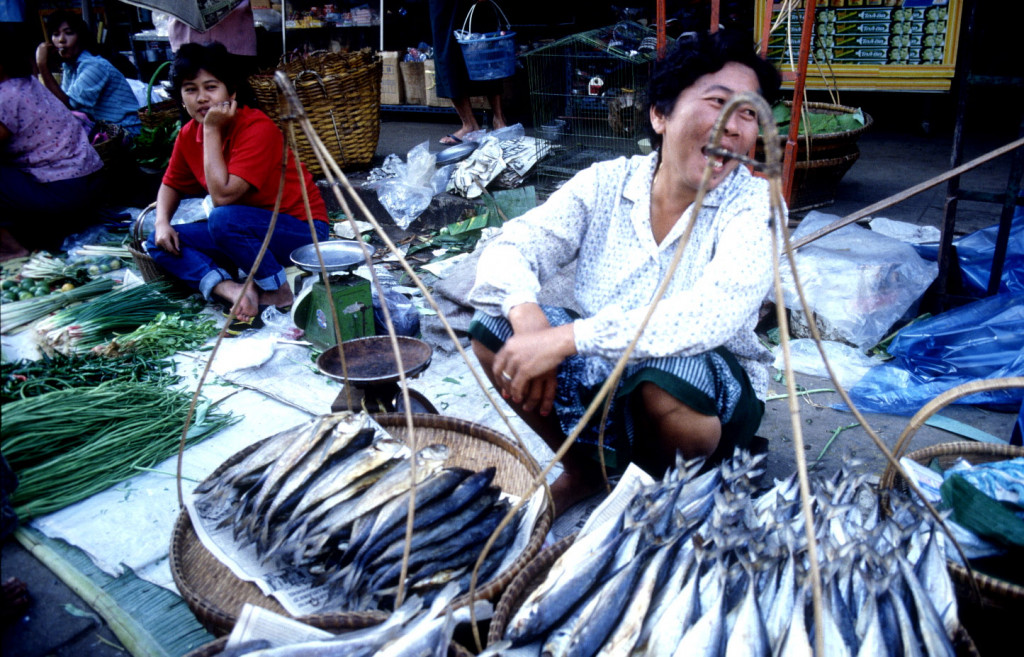
A fisherman fishes in the River Tista in Panjarbhanga, Bangladesh. (Image courtesy FAO/Mohammad Rakibul Hasan)

A fisherman fishes in the River Tista in Panjarbhanga, Bangladesh. (Image courtesy FAO/Mohammad Rakibul Hasan)
The United Nations Food and Agriculture Organization does important work involving fisheries and aquaculture, but from the topics discussed at the 46th Committee on World Food Security, it might not seem that way.
Only one side event during the week-long meeting at the FAO headquarters in Rome was dedicated to fishing, and the fishing industry rarely, if ever, came up during main events. According to people who work on fisheries and aquaculture for the FAO, this is indicative of a larger problem.
“Fisheries in general, by and large, do not gain as much attention or recognition or publicity as terrestrial agriculture,” said Omar Elhassan, an aquaculture biosecurity consultant for the FAO.
Fisheries and aquaculture provide the primary source of animal protein for 17% of the world’s population, according to the FAO. And in low-income, food-deficit countries and small-island developing countries, nearly 25% of people rely on fish for their primary source of animal protein. When it comes to nutrition, fish matter, both globally and locally.
The same is true for employment, as it is estimated that more than 260 million people around the world work in the fishing industry. This number doesn’t necessarily account for those who aren’t employed as fishers but rely on sustenance fishing to feed their families. Aquaculture and fisheries assure the livelihoods of 10% to 12% of the world’s population, or about 770 million to 925 million people.
If you picture huge industrial fishing boats – or the TV show “Deadliest Catch” — when you hear the word “fisherman,” you’re not alone. Industrial-scale fishing tends to dominate how the Western world understands fishing, but it doesn’t reflect the reality for most of the world’s fishers. Small-scale fisheries employ 90% of the world’s capture fishers. Adjust your mental image to include open-air fish markets, small fishing boats, and “The Old Man and the Sea,” and now you’re closer to the truth. Oh, and half the people in your mental image should be women.
Women make up half the workforce of the seafood industry (including both fisheries and aquaculture). Because the fishing activities are often equated with capture fishing and most capture fishers are men, the number of women involved in the fish supply chain has typically been vastly underreported.

“We see some women are fishing, but they are certainly marginalized often because they don’t often get on the boat, and that might also depend on some traditional beliefs – for example, that women are bad luck having on the boat,” said Nicole Franz, a fishery planning analyst for the FAO.
Women do the majority of the post-harvest work in many small-scale fisheries worldwide, whether they are cleaning and selling the fish or repairing fish nets and boats. But carrying these responsibilities doesn’t mean women always have access to necessary resources or to the markets, and they rarely reap the full benefits of their work.
“(Women) don’t necessarily get the fair distribution of benefits within the value chain. If they’re not organized, that’s even worse. We see examples when you have a women’s organization that can act as a trade group together then obviously they can demand higher prices and they’re in a better position to access the market,” Franz said.
The fisheries department at FAO works closely with women’s groups, especially in Africa and Asia, to help support the rights and empowerment of women fishers. Franz cites the recent establishment of a national women fishers’ organization in Tanzania as an example.
Technology can make a critical difference in the fish supply chain, especially in terms of productivity and nutrition. In Africa and southeast Asia, it’s common to dry small fish by placing them directly on the beach. Access to something as simple as a drying rack can completely change how much a small-scale fishing community can gain from their harvest.
“A small innovation like putting this fish on a rack rather than on the floor could make a big difference in terms of the product quality and hence the price, the nutritional qualities, and the overall volume that is produced by these women,” Franz said.

Some traditional fish-smoking processes can cause respiratory illnesses among women and children who are exposed to the smoke. The FAO is working on providing access to better ovens that allow women to work without health risks. Usually, a country or an organization will make a request to the FAO for better technology, and the FAO will provide training on how to build, operate, and maintain the technology. This helps to avoid dividing the market, which is what would happen if some women were directly given the technology and others were not.
“You need to very carefully assess the situation beforehand and discuss with the women themselves a solution on how maybe as a group they can come up with a system where they take turns in accessing this oven or how they divide the benefits of the products that are coming from the use of this improved technology,” Franz said.
Small-scale fisheries also are critically important to indigenous communities, from the Arctic Circle to the coasts of South America. As with women, it’s difficult to track how many fishers are indigenous, but this is an area that the fisheries department of FAO is beginning to dedicate more attention to because of how important fishing is to indigenous peoples around the world.
One of the main issues facing indigenous fishers is the recognition of access rights. Customary or informal access rights are often disregarded when governments develop regulations and create fishing quotas. In the United States, the Fish Wars were a notable series of conflicts between the Washington state government and Native American tribes in the 1960s and 1970s. The state government tried to enforce fishing laws that were in conflict with hundred-year-old treaties held by the tribes, and the U.S. government eventually sided with the tribes.
Tribal governments and organizations can help people organize and assert their rights, and Franz has noticed an uptick in organizing among young indigenous people, especially.
“It’s an expression of this growing awareness and interest to get organized, to get the voice into processes, and to see how the particular issues that indigenous peoples depending on small-scale fisheries are also facing on top of what already is often a challenge for small-scale fishers,” Franz said.
You may be wondering why any of this matters, since climate change is acidifying and warming our oceans, killing our fish, and driving people away from their coastal and island homes. But climate change only makes the need for fisheries-focused work even greater, because the people who rely on fish for income or food will be hit hardest. The role of the FAO, then, is to figure out how to increase the resilience of coastal fishing communities.
“We have colleagues (who) work on climate change impacts on fisheries because obviously, in particular, coastal communities are very, very exposed, and the vulnerability to the impacts of climate change are considerably higher in coastal areas,” Franz said. “They’re looking at the impact both on the resource, in terms of, for example, how stocks are shifting patterns based on the change of temperature in the sea, but also the impacts of increased climate vulnerability on coastal communities.”
Multibillion-dollar fisheries in the United States are threatened by ocean acidification, which impedes the structural development of corals, lobsters, and other marine organisms. One state that is particularly threatened is Alaska, the home of the nation’s largest crab fishery. Alaskans tend to rely more on subsistence harvests than many other Americans, so communities that rely on subsistence crab harvests are especially threatened by the changing ocean. Thousands of miles away in the Caribbean, ocean acidification is harming the coral reefs that are critical to the economies of Florida, Puerto Rico, and the U.S. Virgin Islands. Coral reefs bring in tourism, produce fish to be harvested, and reduce coastal flooding and erosion.
Women and indigenous fishers are especially vulnerable to climate change because their more limited rights and mobility make it harder for them to migrate when their current homes no longer yield enough fish. Increasing their economic mobility and power in the market can make women and indigenous fishers more resilient to climate change.

Destructive fishing practices and overfishing can transform ecosystems and reduce fisheries, sometimes to the point of no return. When there are few regulations over access to a fishery, resources become depleted and communities are devastated.
“What we see often is that there are no regulations for access, and that’s part of an issue in terms of environmental sustainability, because we see growing populations, increased pressure on coastal areas,” Franz said. “On the other hand, for many of these communities, fishing is the only way to make a living, to get food.”
The presence of industrial fishing companies puts pressure on the already tenuous balance of access and protection. Common resource management models include coastal zones that are reserved for small-scale fishers, quota systems assigned to a community or an individual, and co-management systems that allow governments to directly collaborate with small-scale and industrial fishers. But monitoring and enforcement is always a challenge for a government, which is a benefit of co-management.
“It’s about handing over, in many ways, the responsibility for the stewardship directly to the communities by generating a system in which they really recognize and value those management measures because they have co-designed them,” Franz said.
Conflicts between conservation efforts and fishing communities are also a growing issue, especially since national or state governments may create marine protected areas without consulting small-scale fishing communities that will be affected. Conservation has social costs, and just access to resources is sometimes overlooked in pursuit of environmental protections.
“In FAO, what we’re using is the ecosystem-based approach to fisheries, which tries to look at the environmental, the human, and the institutional dimensions together to make sure that these tradeoffs and tensions are identified from the beginning, and that whenever management measures are decided or the use of an area is decided, this is kept in mind,” Franz said.
When negative impacts on the community are unavoidable, it’s important to look out for them in other ways.
“You make sure that either there’s a compensation mechanism or there’s some kind of a safeguarding function to ensure that you’re not having these unintended impacts afterwards that you haven’t even thought about,” Franz said.
Not all fish are harvested from the wild, which is a good thing since climate change and overfishing are shrinking fisheries worldwide. Aquaculture is responsible for about half of global fish production.
Here’s another mental image you may need to adjust: for the most part, aquaculture is not done in factories by large corporations but in backyard ponds by individuals and families. Most aquaculture is small-scale, and 90% of the world’s aquaculture takes place in China and southeast Asia, according to FAO aquaculture biosecurity consultant Omar Elhassan. And again, about half of the people involved are women.

Elhassan believes aquaculture is the future of global fish production, and he notes that aquaculture has been the fastest growing sector of food production since the 1980s. But cultural opinions about it differ greatly from place to place.
“All the fishing zones are essentially at capacity,” Elhassan said. “The only thing that’s going to boost food fish production is (aquaculture), but also it really depends on the cultural mindset towards aquaculture.”
In Asia and Europe, aquaculture tends to be widely accepted, but in the United States, wild-caught fish is believed to have superior freshness and nutrition.
“In the U.S., (fish) is one of the largest trade deficits. All of the fish in the U.S. is essentially just imported from other countries, and it’s a mix of aquaculture and wild-caught,” Elhassan said. But false or misleading labeling leads Americans to believe all of the fish they’re eating came from an ocean or a lake.
In Elhassan’s opinion, there’s nothing inferior about fish, shrimp, or other animals that come from aquaculture versus from the wild. In terms of nutrition, health, and safety, the American distaste for aquaculture has little factual backing.
The main risk faced by aquaculturists is aquatic animal diseases, which can rapidly infect an entire population of animals because it is hard to pinpoint the original source of infection and stop the spread of disease in a pond. Biosecurity is a set of measures that people involved in aquaculture undertake to fortify an aquaculture production facility against aquatic animal diseases, and it’s what Elhassan focuses on at FAO.
“If you’re a small-scale farmer and you lose your entire stock, that can be quite devastating for livelihoods,” Elhassan said. It’s like a corn farmer who loses his entire crop to a flood or a sheep herder who loses his herd to an animal attack.
“Let’s say I’m a small scale aquaculturist and I lost all of my shrimp stock because of a disease, and let’s say that I’m not even in the worst case; I lost my whole stock but I still had some money or I could still take a loan. There’s still persisting problems of having this disease in my pond. Now I have to take all the water out, I have to disinfect the water – can’t just throw it into the environment – and I’m going to have to dry my pond and my soil and sediment and disinfect the things for like at least three months before you would be even allowed to try to produce again,” Elhassan said.
The role of the FAO is to work with governments that request aquaculture biosecurity assistance to try to protect small-scale aquaculturists from losing their livelihoods in this way.
“What really drives a lot of the work, at least for us in the aquaculture branch, is trying to connect different stakeholders such as national, international, government, academia, and small-scale to recognize aquaculture as a truly profitable enterprise,” Elhassan said.

Fisheries and aquaculture are profitable, important industries that employ and feed millions of people – especially women and indigenous peoples – around the world. In recognition of this, the FAO is working to ensure that the needs of fishers, aquaculturists, and the people who rely on their harvests are addressed by the UN. But most public-facing policy conversations in the international community still focus on terrestrial agriculture. Despite the love that many cultures share for the ocean, it seems unlikely that fish will ever hold our attention like cows have.
But on the other hand, Elhassan and Franz measure success through the local impacts of their efforts, not through the global perception of their work. Their focus is the small-scale fisher, not the large-scale policymaker. And maybe that’s for the best – maybe the most impactful work is done when policies for fisheries and aquaculture remain on the smallest scale.